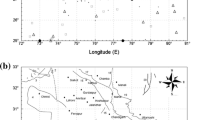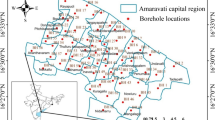Abstract
The assessment of local site effects on seismic ground motions is of great importance in earthquake engineering practice. Several destructive earthquakes in the past have demonstrated that the amplification of ground motion and associated damage to structures due to local site conditions is a significant consideration in earthquake hazard analysis. A recent paper published in this journal highlights the hazard posed by earthquakes in the megacity of Kolkata in India due to its seismic and geological settings. The seismic hazard assessment study speculates that the deep alluvial deposit in the city may increase the seismic hazard probably due to the amplification of the seismic energies. This paper focuses on the seismic response studies of the various soil strata (i.e. for local subsurface conditions) obtained from various construction sites in the city for predicted earthquake. It is very well recognized that site response studies (a part of seismic microhazard zonation for urban areas) are the first step towards performance-based foundation design or seismic risk analysis and mitigation strategy. One of the problems for carrying out site-specific study in Kolkata is the lack of recorded strong motion data in the city. Hence, this paper outlines a methodology to carry out site-specific study, where no strong motion data or seismic data are available. The methodology uses wavelet-based spectrum compatibility approach to generate synthetic earthquake motions and equivalent linear method for seismic site response analysis. The Mega City of Kolkata has been considered to explain the methodology. Seismic hazard zonation map by the Bureau of Indian Standards classifies the City of Kolkata as moderate seismic zone (Zone III) with a zone factor 0.16. On the other hand, GSHAP(Global Seismic Hazard Assessment Program) map which is based on 10% probability of exceedance in 50 years specifies a maximum peak ground acceleration (PGA) of 1.6 m/s2 (0.163 g) for this region. In the present study, the seismic response has been carried out based on GSHAP. The results of the analysis indicate the amplification of ground motion in the range of 4.46–4.82 with the fundamental period ranging from 0.81 to 1.17 s. Furthermore, the maximum spectral accelerations vary in the range of 0.78–0.95 g.

















Similar content being viewed by others
References
Amateur Seismic Centre website, http://www.asc-india.org/.
Bonilla LF, Steidl JH, Lindley GT, Tumarkin AG, Archuleta RJ (1997) Site amplification in the San Fernando valley, California: variability of site-effect estimation using the S-wave, coda, and H/V methods. Bull of the Seism Soc Am 87:710–730
Bouckovalas GD (1997) Prediction of soil effects on seismic motions: a comparative case study. Earthquake Spectra 13(3):333–361
Chang SW, Bray JD, Seed RB (1996) Engineering implications of ground motions from the Northridge earthquake. Bull Seismol Soc Am 86(1B):S270–S288
Chattopadhyay BC (2006) Geology of the basin under Kolkata Megapolis. In: Bhattacharya P (eds) Proceedings of the international workshop on design of foundations in seismic areas: principles and applications. NICEE
Chouinard L, Rosset P, De La Puente A, Madriz R, Mitchell D, Adams J (2004) Seismic hazard analysis for montreal. 13th World Conference on Earthquake Engineering, Vancouver, B.C., Canada, August 1–6, Paper No. 7010
Dobry R, Borcherdt RD, Crouse CB, Idriss IM, Joyner WB, Martin GR, Power MS, Rinne EE, Seed RB (2000) New site coefficients and site classification system used in recent building seismic code provisions. Earthquake Spectra 16(1):41–67
Franco Vaccari M, Walling Y, Mohanty WK, Nath SK, Verma AK, Sengupta A, Panza GF (2010) Site-specific modeling of SH and P-SV waves for microzonation study of Kolkata metropolitan city, India. Pure Appl Geophys. Published online: doi:10.1007/s00024-010-0141-x
Furumura T, Koketsu K (1998) Specific distribution of ground motion during the 1995 Kobe earthquake and its generation mechanism. Geophys Res Lett 25(6):785–788
GovindaRaju L, Ramana GV, Hanumantha Rao C, Sitharam TG (2004) Site-specific ground response analysis. Curr Sci 87(10):1354–1362
Hartzell S, Cranswick E, Frankel A, Carver D, Meremonte M (1997) Variability of site response in the Los Angels urban area. Bull of the Seism Soc of Am 8:1377–1400
Idriss IM, Sun JI (2004) Manual on SHAKE2000—a computer program for the 1D analysis of geotechnical earthquake engineering problems. University of California, Davis
International Building Code (2006) International Code Council. ISBN: 1580012507
IS 1893 (Part 1) (2002) Criteria for earthquake resistant design of structures, Bureau of Indian Standards
Jafari MK, Ghayamghamian MR, Davoodi M, Kamalian M, Sohrabi-Bidar A (2005) Site effects of the 2003 Bam, Iran Earthquake. Earthquake Spectra 21(S1):S125–S136
Jardaneh IG (2004) Evaluation of ground response due to earthquakes—case study. Journal of Applied Sciences 4(3):364–368
Kawase H (1996) The cause of the damage belt in Kobe: the basin edge effects. Seismol Res Lett 67:25–34
Kayen RE, Mitchell JK (1997) Arias intensity assessment of liquefaction test sites on the east side of San Francisco bay affected by the Loma Prieta, California earthquake of 17 October 1989. Nat Haz 16:243–265
Kramer SL (1996) Geotechnical earthquake engineering. Prentice Hall, New York
Lee SH-H (1992) Analysis of the multicollinearity of regression equations of shear wave velocities. Soils Found 32:205–214
Mohamedzein YEA, Abdalla JA, Abdelwahab A (2006) Site response and earthquake design spectra for central Khartoum, Sudan. Bull Earthq Eng 4:277–293
Mohanty WK, Walling MY (2008) Seismic hazard in mega city Kolkata, India. Nat Haz 47(1):39–54. doi:10.1007/s11069-007-9195-1
Mukherjee S, Gupta VK (2002) Wavelet-based generation of spectrum-compatible time-histories. Soil Dyn Earthq Eng 22:799–804
Nandy DR (2007) Need for seismic microzonation of Kolkata mega city. In: Proceedings of workshop on microzonation, Indian Institute of science, Bangalore, India, June 26–27, pp 140–142
Parvez IA, Vaccari F, Panza GF (2003) A deterministic seismic hazard map of India and adjacent areas. Geophysical Journal International 155:489–508
Romero SM, Rix GJ (2005) Ground motion amplification of soils in the upper Mississippi embayment. Report No. GIT-CEE/GEO-01-1, National Science Foundation Mid America Earthquake Center
Seed HB, Whitman RV, Dezfulian H, Dobry R, Idriss IM (1972) Soil conditions and building damage in 1967 Caracas earthquake. Journal of Soil Mechanics and Foundations Division, ASCE 98(8):787–806
Seed HB, Romo MP, Sun JI, Jaime A, Lysmer J (1988) The Mexico Earthquake of September 19, 1985—relationships between soil conditions and earthquake ground motions. Earthquake Spectra 4(4):687–729
Seed RB, Dickenson SE, Idriss IM (1991) Principal geotechnical aspects of the 1989 Loma Prieta earthquake. Soils Found 31(1):1–26
Tsuda K, Steidl J, Archuleta R, Assimaki D (2006) Site-response estimation for the 2003 Miyagi-Oki earthquake sequence considering nonlinear site response. Bulletin of the Seismological Society of America 96(4A):1474–1482
Vucetic M, Dobry R (1991) Effect of soil plasticity on cyclic response. J Geotech Eng ASCE 117(1):89–107
Zaslavsky Y, Shapira A, Gorstein M, Kalmanovich M (2003) Soil response along the coastal plain of Israel for seismic hazard assessments and earthquake scenario applications. Geophys Res Abst 5:01727 (European Geophysical Society)
Zeevaert L (1991) Seismosoil dynamics of foundations in Mexico City Earthquake, September 19, 1985. Journal of Geotechnical Engineering ASCE 117(3):376–428
Zeng X (1996) A simple procedure to calculate the fundamental frequency of horizontal soil layers. Geotechnique 46(4):757–760
Acknowledgments
The first author gratefully acknowledges the National Coordinator Prof. Sudhir K. Jain (IIT Kanpur, India) and Project Implementation Committee (PIC) of NPEEE (India) for the financial support to pursue research at the Department of Engineering Science, University of Oxford (UK). The authors are also thankful to Prof. Vinay K. Gupta (IIT Kanpur, India) for his suggestions and help in development of synthetic earthquake motions for the present studies. The authors would like to thank Dr. Barnali Ghosh, Mr. Shymal Mitra and Mr. Gautam Adak for providing various information in relation to the work. The second author would like to acknowledge the help and support provided by Consulting Engineering Services (India) during his time as a professional engineer in the company.
Author information
Authors and Affiliations
Corresponding author
Rights and permissions
About this article
Cite this article
Govindaraju, L., Bhattacharya, S. Site-specific earthquake response study for hazard assessment in Kolkata city, India. Nat Hazards 61, 943–965 (2012). https://doi.org/10.1007/s11069-011-9940-3
Received:
Accepted:
Published:
Issue Date:
DOI: https://doi.org/10.1007/s11069-011-9940-3




